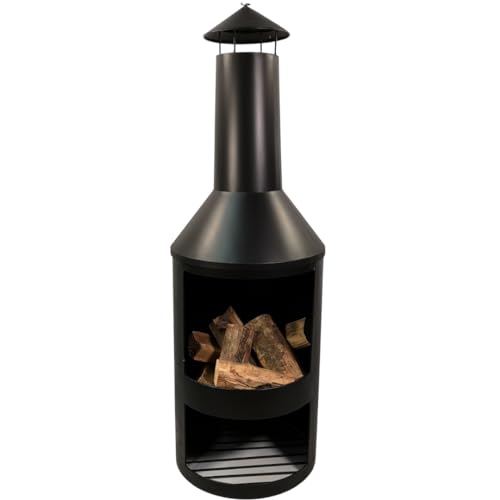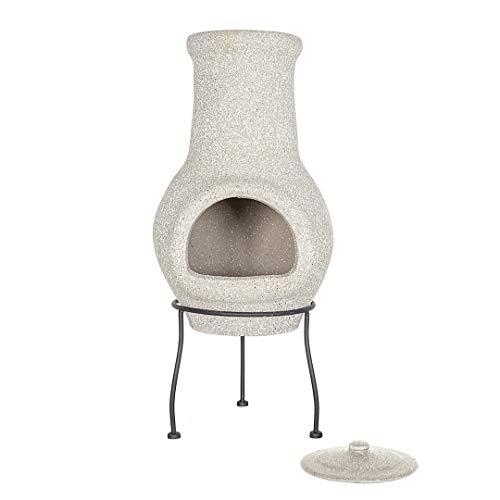A Complete Guide To Clay Chiminea
페이지 정보

본문
 Clay Chiminea - A Fun and Cosy Way to Enjoy the Outdoors
Clay Chiminea - A Fun and Cosy Way to Enjoy the OutdoorsClay Chimineas are a wonderful way to enjoy the outdoors. However, if they're not treated with care, they can break and crack.
To prevent this from happening, you must cure your chimenea. It is crucial to start with small fires and allow it to be heated slowly. This can also help keep sharp pieces of hot clay from flying around!
 How they're made
How they're madeClay chimineas can be made with either dry clay or kiln dried. Kiln drying involves baking the clay in a kiln with temperatures of 1200 degrees or more. The clay is shaped either by hand or by casting it into a mold. Once the clay is formed, it is either coated with glaze (a material such as ceramic or glass is applied to the surface of the clay) or left unglazed. It is also painted to add some decoration.
chimineas for sale can be made of the clay terra cotta which is the same clay used in the production of plant pots. Today, the majority of Chimineas uk are produced in Mexico. A flourishing business that provides local jobs. Chimineas can be fired in small kilns in batches of up to 100 Mexican-style chimineas.
The clay is first rolled into long snakes that are then twisted together to form the shape of the chiminea's body. This is done by hand, with some experience, and it may be difficult to get the clay into the right shape for a chiminea, as they tend to be quite large. Certain chimineas can also be thrown on a wheel like a pottery pot and require expert throwing techniques and the use of tools such as sponges to help the clay to the proper shape.
After the chiminea has been created it is dried in the sun or a oven for several days. After it has dried it can be glazed or unglazed. It is then baked at high temperatures in a ceramic kiln. It may take a couple of firings to completely glaze a clay chiminea and achieve its full fireproofing potential.
Chimines can be fuelled using charcoal or wood and some even make use of them for cooking. Wood is the ideal fuel for a chimenea, as it burns more slowly and produces fewer sparks. Gas burners are not recommended for chimineas since the clay may crack under the pressure created by the flames.
When moving a chimenea never lift it by the chimney or stack - this is a weak point and it can break easily. Place one hand on the area of the mouth, or where the bowl opens, and gently cradle your chimenea's neck with the other hand.
The design
A clay chiminea is a great solution for anyone who wants to add a little space in their outdoor space or just enjoy some natural heat. They're easy to install and appear great however, if you put them in the wrong way, they could be damaged or even explode.
They also need to be cleaned frequently, in order to remove soot and ash from the inside. This ensures that the structure is neat and makes it look much more attractive too. It is recommended to clean it prior to lighting an ember, however it is possible to do it following the event, depending on your preference. Regular cleaning helps reduce the chance of a chiminea becoming ablaze because the accumulation of debris could ignite and cause structural damage.
A layer of sand or lava stone, could be positioned on the bottom of your fireplace. This will protect your clay from the heat produced by the burning of coals and wood which could cause it crack. Most people use a bag to each chiminea. However, lava stones can be an excellent alternative for those looking to get something a little more refined.
You can create a hearth for your patio around your chiminea, providing an area that is safe for it to be set up. They are usually constructed by covering a portion of a deck or patio with pavers or non-combustible materials, creating an elevated platform for your chiminea. It is possible to move it around to prevent it from being too close to trees or structures. It is also simple to douse the fire with water, without having to worry about causing harm to the surrounding area.
While you can use a chiminea its own, it's often best to pair them with a grill. This lets you cook food while keeping your chiminea warm. It also gives you the opportunity to experiment with various cooking methods, which isn't always possible when using the traditional fire pit. Keep in mind that chimineas can be extremely heavy, and larger ones should only be moved once they are completely cool or with the help of a companion. Covering them when not in use can increase their lifespan.
The chimney
A chiminea is basically clay pots that have a chimney. It can be placed anyplace to create warmth and ambience. Chimineas can be used to cook charcoal or wood. They are also very attractive and are a great addition to any furniture on your patio. They are easy to maintain and can last for many years. They can be painted to match the decor non-toxic paints. A cover can prolong the lifespan of your gazebo by shielding it from debris and weather.
Like all pots like any other, a clay chiminea is susceptible to various elements such as extreme heat and rain. To ensure that your chiminea is in good shape you must regularly clean it. You'll need to clean the inside of your Chiminea using a stiff bristled toothbrush. The next step is to clean the exterior of your fireplace using mild soap and a soft cloth.
It is also recommended that you place a layer sand or stone on the bottom of your chiminea bbq. This will stop the hot coals directly touching the clay, causing cracking of the heat. Lava stones are a favorite and provide an additional layer of protection for your chiminea.
Both cast iron and clay can withstand high temperatures however, they must be maintained carefully to avoid breaking or cracking. A chiminea that has damaged or cracked may crack open, releasing an ash and causing a fire hazard.
Chimineas made from clay can be repaired with high-temperature epoxy adhesives, which are readily available in a majority of hardware stores. However unlike traditional flowerpots made from clay they must be repaired using products that are able to stand up to high temperatures.
Like any fireplace one can expect a chiminea to generate hot sparks whenever you light it. You can limit the amount of sparks with well-seasoned, trimmed wood. Also, place a mesh screen on the top rated chiminea of the stack. Installing a metal grate on the opening of your chiminea can also aid in reducing the amount of sparks emitted out of it.
The firebox
If you want to add a convenient and warm outdoor fire feature to your living space, the clay chiminea (also known as a chimenea) might be just the right thing. These simple modular units are available in a variety of styles and materials to fit any home or yard setting.
Generally, these structures include a fire bowl, main body to feed and hold the wood, and a chimney stack to allow the expulsion of smoke and ash. Some might also include grills and other cooking components for those who want to make their chimineas an outdoor kitchen.
Like all clay pots, a chiminea also requires regular maintenance to keep it in good shape. The most obvious issue with clay is that it can break and crack if exposed to excessive stress, like abrupt temperature fluctuations. To prevent this from happening, you should place your chiminea in a stable space such as a fire pit, a firepad, or on concrete or stone.
In addition to ensuring that you keep your chiminea on solid ground it is also advisable to keep the flames inside the fire bowl as tiny as you can. A large fire can cause the clay to break and shatter. This can cause extremely sharp pieces of hot clay to fly off and be hazardous to pets and children who may be around.
The best way to prevent this is to "season" your chiminea prior you use it for the first time. It is recommended to make four to eight small fires in order to seal the clay. After each fire, allow the chiminea to cool completely before attempting another one.
If you take care of your garden chiminea correctly it will last for years. Some modern chimineas are made of clay that is heavily grogged to ensure they are more resistant to temperature fluctuations which can cause cracks or breakage to other kinds of chimineas. In the event of rain it is an ideal idea to use a chiminea cover. This will shield it from rain, sleet and snow and also reduce the amount of heat that is lost during the rainy season.
- 이전글What Are The Myths And Facts Behind Big Chiminea 24.11.22
- 다음글Fire Pits & Chimineas Tools To Streamline Your Everyday Lifethe Only Fire Pits & Chimineas Trick Every Person Should Know 24.11.22
댓글목록
등록된 댓글이 없습니다.


